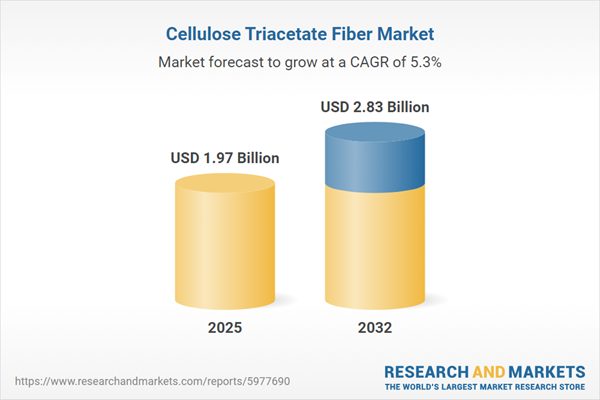Speak directly to the analyst to clarify any post sales queries you may have.
Senior executives in the cellulose triacetate fiber market are navigating substantial change amid evolving regulations, sustainability demands, and customer expectations. In this dynamic landscape, access to actionable, market-specific insights is crucial for steering high-level planning and ensuring competitive leadership.
Market Snapshot: Strategic Overview of the Cellulose Triacetate Fiber Market
The cellulose triacetate fiber market continues to display resilient growth, with the latest market intelligence affirming its upward trajectory from USD 1.87 billion in 2024 to a projected USD 2.83 billion by 2032, maintained by a robust 5.32% CAGR. This expansion is attributed to technological advancements in manufacturing, heightened scrutiny in regulatory frameworks, and industry-wide emphasis on sustainable sourcing solutions. Leading market participants are proactively adopting transparency measures and strengthening compliance structures to elevate standards for governance and supply chain management. By prioritizing resource efficiency and targeted sustainability, these organizations are positioning for incremental progress and robust market resilience.
Scope & Segmentation of the Cellulose Triacetate Fiber Market
This report delivers an in-depth segmentation, enabling strategic alignment across core business functions and geographies. Broad segment coverage ensures stakeholders can address operational, compliance, and technical imperatives effectively.
- Applications: Includes cigarette filters, technical filtration, reinforcement materials, apparel, home textiles, and automotive interiors. Each presents distinct compliance challenges, sector-specific performance demands, and evolving end-user standards.
- Product Forms: Covers filament yarns and staple fibers, supporting a spectrum of production workflows for responsive customer engagement and adapting to changing market conditions.
- End Uses: Encompasses automotive interiors, industrial textiles, specialty equipment, and apparel, emphasizing quality, durability, and rigorous safety conformity.
- Grades: Details flame retardant, high tenacity, and standard variants—each engineered to meet specific technological applications and ensure compliance with emerging requirements.
- Production Processes: Highlights both dry spinning and wet spinning technologies, enabling cost control and improved resource utilization aligned with sustainability targets.
- Regions: Profiles Americas, Europe, Middle East, Africa, and Asia-Pacific, with attention to regional regulatory demands and tailored strategies for market access and operational localization.
- Leading Companies: Lists major producers, such as Eastman Chemical Company, Celanese Corporation, Daicel Corporation, Mitsubishi Chemical Corporation, Kolon Industries, Sateri Holdings Limited, and Grasim Industries Limited, reflecting an interplay of innovative drive and established expertise.
Key Takeaways for Senior Decision-Makers
- Cellulose triacetate fiber underpins essential applications, enabling consistent product reliability across filtration, industrial, and textile sectors, thereby supporting core operational continuity.
- Greater incorporation of renewable raw materials and adoption of circular value chains are strengthening supplier relationships, while facilitating measurable progress toward broader corporate sustainability commitments in chemicals and textiles.
- Enhanced transparency and supply chain traceability are now fundamental, as they ease compliance demands, minimize reputational exposures, and build sustained regulatory and stakeholder trust.
- Collaborative partnerships and flexible supply chain management are increasingly central as organizations address evolving regulatory landscapes and adapt to shifting end-market priorities, ensuring timely responsiveness and stability in unpredictable business climates.
- Regional considerations strongly influence strategic focus, with Asia-Pacific emphasizing scale and cost efficiency and EMEA concentrating on tightening compliance and aggressive sustainability performance to retain competitive edge.
Tariff Impact: Navigating Regulatory Complexity
Recent US tariff changes are driving cellulose triacetate fiber manufacturers to adjust procurement strategies and enhance localization. Senior leaders are mitigating risk by diversifying their supplier base, increasing investment in local production, and deepening supplier partnerships. Integrated planning between manufacturing and logistics has emerged as a priority, fostering regulatory alignment, preserving market access, and maintaining business continuity amid heightened trade complexities.
Methodology & Data Sources
This market intelligence report synthesizes a comprehensive analysis of sector publications, expert interviews, and validated structured datasets. Accredited specialists rigorously verify each finding, ensuring executive decision-makers receive detailed, accurate, and strategy-oriented guidance.
Why This Cellulose Triacetate Fiber Market Report Matters
- Strengthens executive segmentation analysis and value chain insight, informing enhanced procurement, targeted investment, and proactive risk management across all chemical and textile verticals.
- Provides frameworks for effective benchmarking and supports ongoing regulatory compliance, positioning organizations for sustained operational excellence as industry requirements evolve.
- Enables leadership to build agile and sustainable supply chains, enhancing resilience and adaptability across diverse and rapidly evolving geographic markets.
Conclusion
This report delivers the critical intelligence needed for reliable compliance, forward-thinking sustainability, and solidification of competitive strategies. Leverage these insights to inform decisive, future-ready actions in the cellulose triacetate fiber market.
Additional Product Information:
- Purchase of this report includes 1 year online access with quarterly updates.
- This report can be updated on request. Please contact our Customer Experience team using the Ask a Question widget on our website.
Table of Contents
3. Executive Summary
4. Market Overview
7. Cumulative Impact of Artificial Intelligence 2025
Companies Mentioned
The companies profiled in this Cellulose Triacetate Fiber market report include:- Eastman Chemical Company
- Celanese Corporation
- Daicel Corporation
- Mitsubishi Chemical Corporation
- Kolon Industries, Inc.
- Sateri Holdings Limited
- Grasim Industries Limited
Table Information
| Report Attribute | Details |
|---|---|
| No. of Pages | 183 |
| Published | November 2025 |
| Forecast Period | 2025 - 2032 |
| Estimated Market Value ( USD | $ 1.97 Billion |
| Forecasted Market Value ( USD | $ 2.83 Billion |
| Compound Annual Growth Rate | 5.3% |
| Regions Covered | Global |
| No. of Companies Mentioned | 8 |









